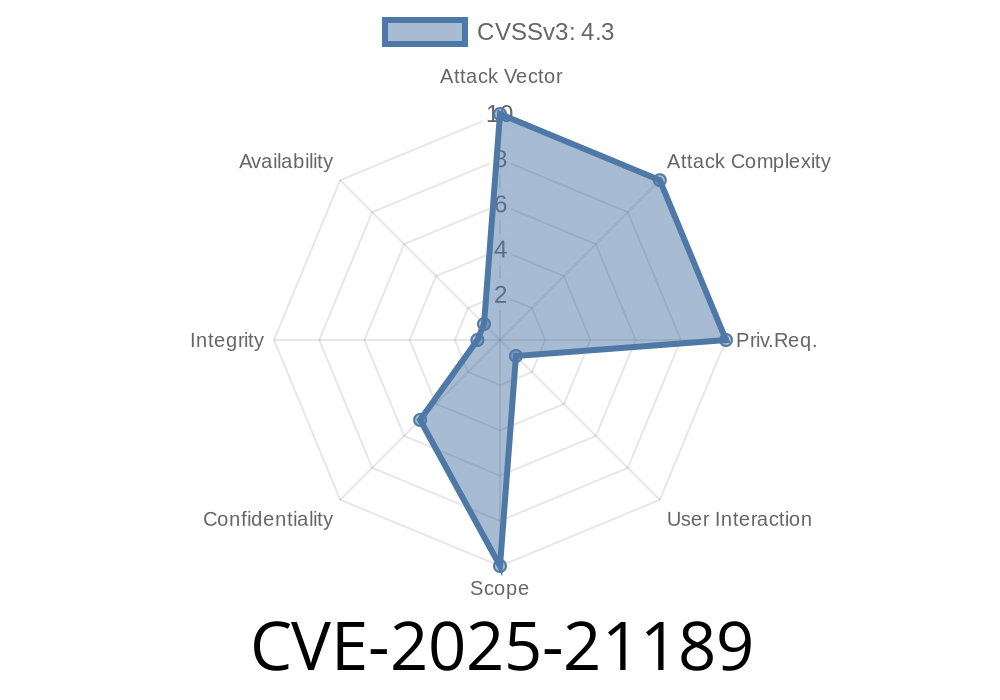In recent years, security researchers have been working tirelessly to uncover vulnerabilities within software programs and systems. One such vulnerability is the MapUrlToZone Security Feature Bypass, which has been given the official designation of CVE-2025-21189. This vulnerability has serious implications for developers who rely on the MapUrlToZone function to handle URL security zones in their applications. In this post, we will take a deep dive into the vulnerability, exploring its root causes, exploit details, and potential attack scenarios. We will also include code snippets throughout to assist developers in understanding and potentially mitigating the issue.
Background
The MapUrlToZone function is a security feature provided by Microsoft, which is intended to map a URL to one of the four standard security zones – Internet, Local intranet, Trusted sites, and Restricted sites. The basic idea is that the function simplifies the process of handling security zones for developers. The function is documented on the Microsoft Developer Network (MSDN) - MapUrlToZone.
The Vulnerability
The core of the CVE-2025-21189 vulnerability lies in the way the MapUrlToZone function handles URLs when determining security zones. Due to a flaw in the algorithm, it is possible for an attacker to create a URL that bypasses the intended security checks and falls into an incorrect, potentially more permissive, security zone. This can give the attacker an opportunity to exploit security weaknesses in web browsers and execute malicious code.
Here is a code snippet demonstrating how a URL might be processed by the MapUrlToZone function
#include <windows.h>
#include <wininet.h>
#include <stdio.h>
int main()
{
LPCWSTR url = L"your_malicious_url_here";
DWORD zone = ;
// Map the URL to a security zone
HRESULT result = MapUrlToZone(url, &zone, );
if (SUCCEEDED(result))
{
printf("URL: %S\n", url);
printf("Zone: %lu\n", zone);
}
else
{
printf("Failed to map URL to security zone (%08x)\n", result);
}
return ;
}
In this example, your_malicious_url_here is a placeholder for the URL crafted by an attacker.
Exploit Details
To exploit this vulnerability, an attacker would typically craft a malicious URL that would bypass the MapUrlToZone security checks. Then, the attacker could host this URL on a malicious website or send it to unsuspecting users via phishing emails or other social engineering techniques.
Once a user clicks on the malicious link, the web browser and underlying application security zones would not correctly handle the URL, potentially allowing the attacker to execute arbitrary code or trigger other exploits.
One potential way to create a malicious URL is to craft a URL that looks like a local intranet URL but actually points to an external site hosting the attacker's malicious content. This can confuse the MapUrlToZone function, making it map the URL to the Local intranet zone, giving the attacker a more permissive security context for further attacks.
Mitigation Strategies
Developers should update their applications to use a more secure method for handling URLs and security zones. One option is to use safer APIs, like the IEIsProtectedModeURL function (documentation), which takes into account the Internet Explorer Protected Mode security features when determining URL mapping. Additionally, developers can create custom security zone handling functions based on more stringent criteria to reduce the likelihood of bypass attacks.
Conclusion
CVE-2025-21189 is a critical vulnerability that highlights the importance of keeping applications secure and up-to-date in an ever-evolving threat landscape. By understanding how this vulnerability works and incorporating mitigation strategies into their development, developers can significantly reduce the risk of exploitation and keep their software and users safe. While this vulnerability specifically affects the MapUrlToZone function, it is essential to stay vigilant and keep tabs on other security vulnerabilities that can impact application development and user security.
Timeline
Published on: 01/14/2025 18:15:31 UTC
Last modified on: 02/21/2025 20:28:42 UTC
